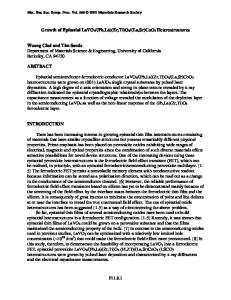Thermal Stability and Semiconducting Properties of Epitaxial La 0.7 Sr 0.3 MnO 3 Films
- PDF / 292,814 Bytes
- 6 Pages / 391.5 x 607.5 pts Page_size
- 112 Downloads / 304 Views
ABSTRACT Lao. 7Src. 3MnO 3 (LSMO) perovskite oxide films have been grown on (001) LaA10 3 (LAO) by pulsed laser deposition. The films were deposited in an ambient oxygen pressure of 0.1 mTorr to 200 mTorr and under different substrate temperatures. Their structural properties were examined by X-ray diffractometry. Heteroepitaxial growth was confirmed for films deposited at 650'C or above. Electrical measurements suggest that the charge carrier concentraticn of the films varies with their oxygen content and shows high stability against further thermal treatment. Semiconducting LSMO films at room temperature were obtained for 60 mTorr. The epitaxial LSMO films have been used as the deposition at oxygen pressure _< semiconducting channel of a ferroelectric field effect transistor. Heteroepitaxial Pb(Zro.52Tio.48)0 3/LSMO/LAO structures have been fabricated and characterized. INTRODUCTION In recent years, great attention has been paid to the maganese perovskites due to their unique physical properties such as colossal magnetoresistance (CMR) [ 1-7] and half metallic with spin polarization [8-10] at the Fermi level. These properties make the maganese perovskites a useful materials for magnetoresistive devices such as magnetic random access memory and magnetic field sensors. By controlling the electrical transport properties of these materials in thin film form, however, the materials can be used as semiconducting layers in electronic devices such as ferroelectric field effect transistor (FeFET) [11,12]. La0.TSr 0.3MnO 3 (LSMO), like other mangenese oxides, is a candidate for fabricating such FeFET. In our present study, where the LSMO films. were fabricated by pulsed laser deposition (PLD), we found that the LSMO is a more suitable material than other mangenese oxides due to its easily tuned semiconducting properties, high thermal stability [13] and low processing temperature. Heteroepitaxial Pb(Zro.52Tio08)O 3(PZT)/LSMO/ LaA10 3 (LAO) structures with semiconducting LSMO channel have been fabricated. EXPERIMENT A 248 nm KrF excimer laser with a repetition rate 10 Hz was used to ablate stoichoimetric targets of LSMO and PZT. Films were deposited on (001) LAO single-crystal substrate under different conditions. The laser fluences were kept at 6 J/cm 2 and 3 J/cm 2 for irradiating the LSMO and PZT targets respectively. The target-substrate distance was 45 mm. The substrates were cleaned in acetone and rinsed with deionized water. They were then glued to the surface of the substrate heater by silver paste. The position of the heater was aligned to the centre of the plume in order to obtain the best uniformity of a grown film. The typical layer thickness for LSMO and PZT were 200 nm and 150 nm, respectively. LSMO/LAO and PZT/LSMO/LAO heterostructure were characterized by four-circle X-ray diffractometry using CuKL. radiation. 77 Mat. Res. Soc. Symp. Proc. Vol. 623 © 2000 Materials Research Society
The resistivity-temperature (R-T) curves of the LSMO films were measured by a standard fourpoint probe technique over a tempera
Data Loading...











